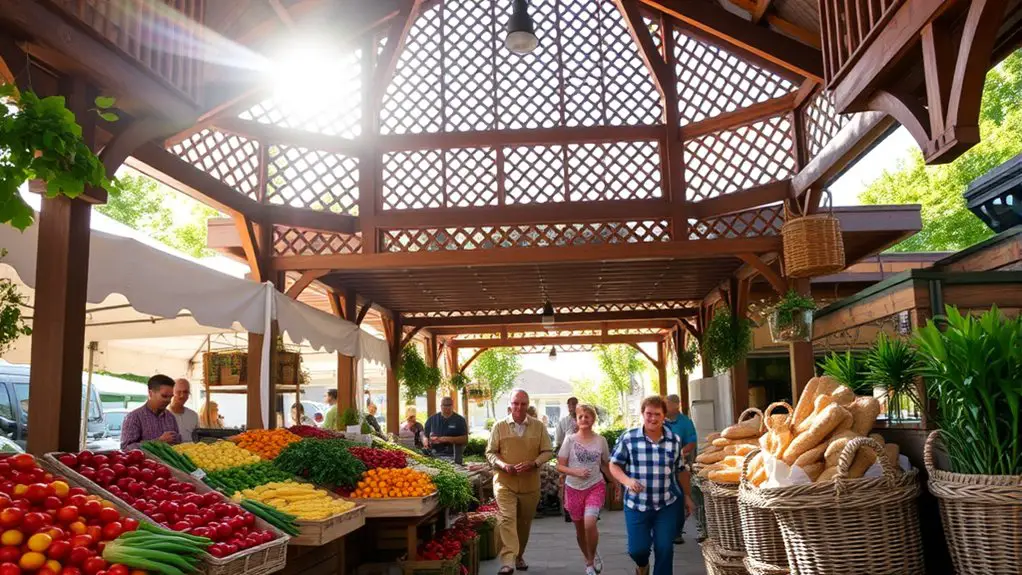Hosting a seasonal farmers’ market under your gazebo can be a delightful community experience. Start by choosing the right date, ideally in spring or summer, and invite local vendors passionate about their crafts. Set up your gazebo for maximum visibility, arrange stalls to encourage exploration, and create seating areas for relaxation. Promote your market through social media and local flyers, and engage visitors with fun activities. Keep an eye on sustainability for a lasting impact and discover more tips to elevate your market!
Choosing the Right Date and Time
When’s the best time to host your seasonal farmers’ market? The answer lies in understanding seasonal considerations and keeping an eye on weather forecasts. Ideally, aim for a date that aligns with local harvests, allowing you to showcase fresh produce. Spring and summer often bring vibrant fruits and vegetables, creating a lively atmosphere that draws in visitors.
Consider your community’s calendar, too. Avoid clashing with major events that might divert attention from your market. Early mornings or late afternoons tend to attract more foot traffic, as people enjoy leisurely shopping before or after their daily routines.
Check long-term weather forecasts to dodge any unexpected rain or extreme temperatures. You want your market to be a comfortable and enjoyable experience for everyone. By thoughtfully choosing the right date and time, you can create a welcoming space that celebrates local flavors and fosters community connections.
Inviting Local Vendors and Artisans
To create a vibrant farmers’ market, it’s essential to invite local vendors and artisans who can showcase the unique flavors and crafts of your community. Start with effective vendor outreach; reach out to farmers, bakers, and crafters who share a passion for quality and sustainability. Use social media, community boards, and local networks to spread the word and attract diverse participants.
When it comes to artisan selection, aim for variety. Consider including handmade goods, organic produce, and artisanal foods to cater to different tastes. Encourage vendors to share their stories and techniques, enriching the market experience for everyone involved.
Don’t forget to establish a welcoming atmosphere, where collaboration thrives. By focusing on these key aspects, you’ll not only enhance the market’s appeal but also strengthen community bonds, giving everyone a sense of belonging and freedom to explore local creativity.
Setting Up Your Gazebo and Market Layout
As you prepare to set up your gazebo and market layout, it’s essential to reflect on both functionality and aesthetics to create an inviting space. The right gazebo placement can enhance visibility and accessibility while ensuring a smooth market flow. Here are three key steps to evaluate:
- Choose the Right Location: Position your gazebo for maximum exposure, ideally near the entrance, to attract foot traffic.
- Design Your Layout: Arrange vendor booths in a way that encourages exploration. Think about a circular or serpentine layout to promote easy movement through the market.
- Incorporate Seating Areas: Add benches or picnic tables near the gazebo, providing a relaxing spot for visitors to enjoy local foods or crafts while enhancing the overall atmosphere. Additionally, consider the sun and shade exposure of your gazebo location to ensure visitor comfort throughout the day.
With these tips, you’ll create a vibrant farmers’ market that invites community engagement and celebrates the joy of local produce.
Promoting Your Farmers’ Market
Now that your gazebo and market layout are set, it’s time to focus on getting the word out about your farmers’ market. One of the most effective ways to promote your market is through social media. Create engaging posts that showcase your vendors and the fresh produce they offer. Use vibrant images and local hashtags to reach your community.
Don’t forget about promotional materials! Design eye-catching flyers and posters to hang in local businesses, coffee shops, and community centers. Consider offering a referral program or incentives for those who bring friends.
Engage with local influencers who align with your market’s values—they can help amplify your reach. Finally, be sure to create a Facebook event or Instagram page dedicated to your market, where you can share updates and interact with customers. By combining social media with traditional promotional materials, you’ll draw in a diverse crowd enthusiastic to explore all your market has to offer!
Engaging the Community With Activities
To truly engage your community at the farmers’ market, consider hosting interactive workshops that cater to all ages, from cooking classes to gardening tips. Adding live music and entertainment will create a vibrant atmosphere, drawing in more visitors and encouraging them to linger. These activities not only enhance the market experience but also foster connections among attendees, reinforcing the sense of community.
Interactive Workshops for All
While engaging with your local farmers’ market, you might discover that interactive workshops can transform a simple shopping trip into an enriching community experience. These hands-on activities not only educate but also foster connections among participants. Consider incorporating the following workshop themes:
- Culinary Skills: Teach attendees how to prepare seasonal dishes using fresh produce.
- Gardening Basics: Share tips on growing herbs and vegetables in limited spaces.
- Crafting with Nature: Encourage creativity by crafting with natural materials found in the market.
These workshops invite everyone to participate, learn new skills, and share stories, making your market a vibrant hub of community engagement. Embrace this opportunity to empower individuals and celebrate local resources!
Live Music and Entertainment
As you stroll through the bustling farmers’ market, the sounds of live music can instantly uplift your spirits and create a lively atmosphere. Incorporating live performances not only entertains but also fosters community engagement. Imagine local bands serenading you while families gather to enjoy the tunes, creating connections and memories.
You might consider scheduling diverse acts—folk, jazz, or even a local school choir—to attract different crowds. Dance workshops or open mic sessions can invite participation, allowing visitors to showcase their talents and join the fun. By providing a stage for creativity, you’re not just hosting a market; you’re building a vibrant community hub. So, let the music play, and watch as your farmers’ market transforms into a celebration of local culture and connection.
Ensuring a Sustainable and Enjoyable Experience
Creating a sustainable and enjoyable experience at a seasonal farmers’ market requires thoughtful planning and collaboration among vendors, organizers, and the community. By focusing on sustainable practices and incorporating eco-friendly vendors, you can foster a vibrant atmosphere that resonates with attendees. Here are three key strategies to enhance your market:
Fostering a vibrant seasonal farmers’ market requires collaboration, sustainable practices, and community engagement for a memorable experience.
- Encourage Local Sourcing: Partner with nearby farmers and artisans to reduce transportation emissions and support the local economy. This way, your community thrives together.
- Promote Waste Reduction: Provide compost bins and recycling stations to minimize waste. Encourage vendors to use biodegradable packaging, creating a cleaner environment.
- Engage the Community: Host workshops on sustainability and eco-friendly practices. When people learn and share, they’re more likely to return and spread the word.
Frequently Asked Questions
What Permits Are Needed for Hosting a Farmers’ Market?
When hosting a farmers’ market, you’ll need to check local vendor regulations and obtain the necessary market licenses. Ensuring compliance keeps your event enjoyable and hassle-free, so you can focus on connecting with your community.
How Do I Handle Payment Processing for Vendors?
To handle payment processing for vendors, explore digital payment solutions like mobile apps and online platforms. Additionally, consider vendor invoicing options to streamline transactions, ensuring everyone can focus on enjoying the market experience without financial hassle.
What Insurance Coverage Should I Consider?
You might think skipping insurance is a great idea, but liability insurance is essential. Don’t forget vendor coverage, either. With all those delicious goods around, it’s best to protect yourself from unexpected mishaps!
Can I Host a Farmers’ Market in Any Location?
You can’t host a farmers’ market just anywhere. Consider location accessibility for vendors and customers; it should be easy to reach. Look for areas with high foot traffic and adequate parking for a successful market experience.
What Should I Do in Case of Inclement Weather?
Did you know 30% of outdoor events face inclement weather? For yours, have rainy day preparations ready and establish vendor contingency plans. Keep everyone informed and guarantee a smooth experience, rain or shine.

